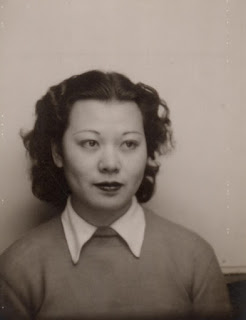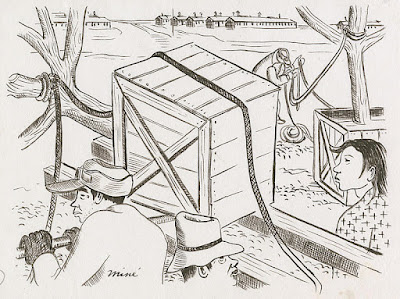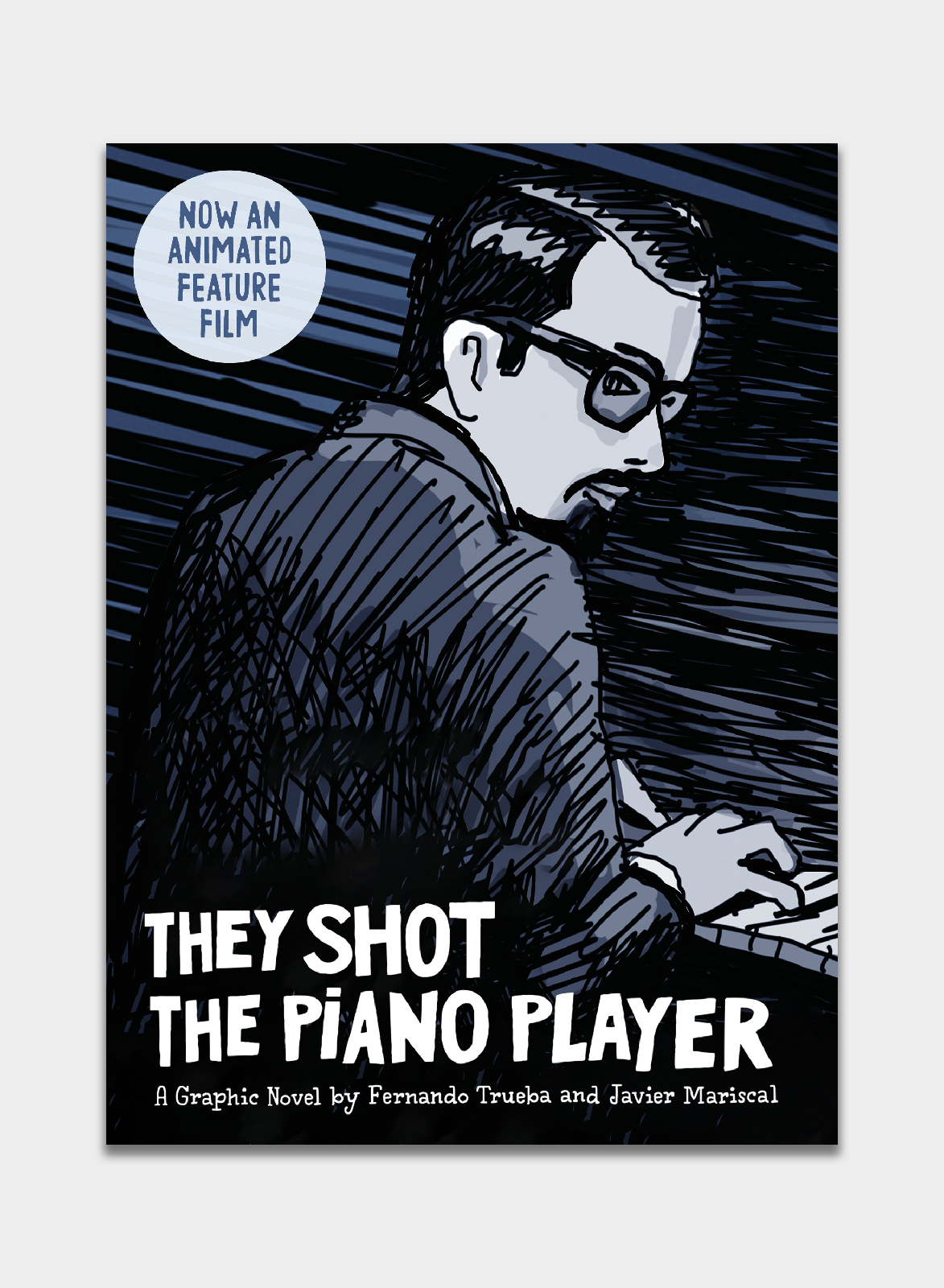 Miné Okubo’s Masterpiece: The Art of Citizen 13660. Los Angeles: Japanese American National Museum, August 28, 2021 -
February 20, 2022. <https://www.janm.org/exhibits/mine-okubo-masterpiece/>
Miné Okubo’s Masterpiece: The Art of Citizen 13660. Los Angeles: Japanese American National Museum, August 28, 2021 -
February 20, 2022. <https://www.janm.org/exhibits/mine-okubo-masterpiece/>
reviewed by Tony Wei Ling
The museum’s path is
a loop, and so a visit to JANM’s Citizen
13660 exhibit either begins or ends with a view into the same shambly
wooden structure: an original barracks removed and rebuilt from the Heart
Mountain concentration camp. Part of JANM’s ongoing exhibit on Japanese
American history, Common Ground, this
building-inside-a-building bookends the celebration of “Miné Okubo’s
Masterpiece.” Visitors first travel through Common
Ground’s rooms, which span the earliest waves of immigration through to
WWII incarceration and its aftermaths; the final room, situated just before the
entrance to the Okubo exhibit, covers the 1970s/80s political struggle for
redress that followed internment. Along with the architectural bookend of the
barracks, this history of the Redress Movement physically frames the museum’s
75th anniversary exhibit of Citizen 13660.
The
JANM exhibit is structured into a narrative of the book’s production,
displaying the variety of materials (varied camp sketches, original Citizen 13660 drawings, and page mockups
combining drawing, typed caption, and marginal edits) in a
compositional/editorial process of negotiated meaning. Miné Okubo’s iconic 1946
book pairs observational cartoons with terse first-person captions and follows
Okubo through multiple relocations and incarcerations between 1939 and 1944:
Berne to Berkeley, Tanforan to Topaz. By laying out the Citizen 13660 exhibit, room by room, into stages of drafting,
design, and correction, the exhibit opens up for interrogation the multiple
actors and influences that brought it into publication.
 |
| Mine sleeping on a cot in her barrack |
| |
Such
an interrogation is important because Citizen
13660’s rendering of camp life’s “humor and pathos” has often been
preemptively read as a political act in itself, one that critiques the events
it charts and anticipates the organized call for reparations. No doubt much of
this reputation comes from the book’s use as testimony in the 1980s, during
which Okubo submitted her book to the Congressional Commission on Wartime
Relocation and Internment of Civilians as evidence of government wrongdoing.
However, scholars like Christine Hong warn against subsuming the book within
this “retroactive interpretive lens,” since doing so “arguably obscures more
than it illuminates Okubo’s legacy as a wartime artist.” Indeed, as Hong
reminds us, Citizen 13660 could only
have been published immediately following the war (and during the cross-country
dispersal of former incarcerees) with the support of the WRA officials who ran
the camps, some of whom endorsed the book. The book became, perversely, “an
affirmation of the democratic potential of the American concentration camp,”
Hong writes. This affirmation required fitting Okubo into the exemplar of an
“entirely American” Nisei character (to quote Pearl Buck), such that reviews of
her book sounded almost identical to the artist’s truly wild character
references, such as the one from her teacher Glenn Wessels describing her as
“un-Japanese in sympathies and in manner of thought.”
Citizen 13660’s legacy has continued to
work through this exemplar form, making Okubo into an ethnic representative
whose witnessing and recording of the camps always already testifies to one
political end or another: either a distinctly American story that mines the
everyday adjustments and discomforts of camp life for common ground with white
readers, or a sharply critical, irony-laden statement of racial protest.
Debates about how best to interpret “Miné Okubo’s Masterpiece” as a politically
potent (though not obvious) artistic work are not about pinning down the
precise political character of a single cultural figure: they are about
dislodging both the book and the artist from the position of exemplar. Hong’s
caution not to read Citizen 13660 through
a single lens clarifies the pressures of exemplarity as a representational
mode, which can attempt to redeem ambiguous or close-mouthed texts by forcing
them to speak.
Although
the museum’s physical layout leads the visitor straight from redress to Okubo,
JANM seems to follow Hong’s caution not to enclose the artist within the
political lens of redress. The curatorial writings about the exhibit are
relatively circumspect on Okubo’s politics; they describe the book as
“groundbreaking” for being “the first book-length account on America’s
concentration camp from the perspective of a former incarceree” and “an early
example of a graphic memoir,” not for being a self-evident critique of the
state.
 |
| Memorial service for James Wakasa |
Perhaps
more importantly, the exhibit’s design draws the visitor’s attention to edits
made to both Okubo’s text and drawings, asking the visitor to compare versions
of the same page. One key moment in the exhibit places a page from the final
book next to its draft page mockup: it’s the page in which Okubo addresses a
guard’s fatal shooting of an “elderly resident.” The final version’s caption
consists of a single paragraph, from which much of the draft page’s typewritten
details have been cut. Ironically, one of the remaining lines in the published
version reads: “Particulars and facts of the matter were never satisfactorily
disclosed to the residents.”
 |
| Detention room filled with departing residents |
What did it mean to excise those
slight elaborations on “the Wakasa case” from the final publication? And what
can readers today make of such an elision, in this already famously elliptical
work? Against the backdrop of its various political mobilizations
(re-domesticating alienized incarcerees, testifying towards redress), Citizen 13660 might be best
characterized by its oscillations and reticence––qualities that JANM’s exhibit
faithfully reflects and interrogates through its attention to revision and
editorial process. JANM’s Education Unit has designed a wonderful activity
guide that asks visitors to participate in slow examination of Okubo’s drawings
through activities in “close looking,” comparison between early sketches and
final versions, and even invitations to draw one’s own illustrations from
Okubo’s captions.
Over
the decades, Citizen 13660 has been
made a representative of multiple political/racial narratives––narratives not
obviously cosigned or directly produced by the work itself. These interpretive
frames are partly external impositions on the book, but they are also generated
in large part by the work’s odd combination of documentation and reticence. A
strategy of “documentation through reticence,” in fact, might be fitting to
stress the scientist’s objectivity in Okubo’s textual voice. Or maybe
“reticence through documentation”: the book rattles off a steady rhythm of
particulars to fill incarceration’s empty time. “You had to work hard to keep
yourself going, and to keep from thinking,” Okubo said in a post-publication
interview. And as Greg Robinson observes, “Okubo may not have been referring
simply to her camp experience,” but to the stifling representational burden of
Americanizing/humanizing incarcerees.
 |
| Landscaping with trees |
Another
way of looking at Okubo's reticence is as a strategy of abstraction––as a
stylistic register that responds to the pressures of racial exemplarity.
Talking about Citizen 13660 in terms
of abstraction may seem odd, given the work’s obvious claims to figurative
representation (as documentary) and its obsessive interest in particulars:
barrack and room numbers, curfew times, toilet arrangements, wages. Its text
and image move at different paces, though, and rather than elaborating or
contextualizing the moments depicted in each drawing, Okubo’s captions often
direct the reader and characters onward, onward, onward, at a brusque pace
something like a punchline.
“Everyone was building furniture and fixing up
barracks and stalls. Many of the discomforts of the camp were forgotten in this
activity.”
“Letters from my European friends told me how
lucky I was to be free and safe at home.”
“The incomplete partitions in the stalls and
the barracks made a single symphony of yours and your neighbors’ loves, hates,
and joys. One had to get used to snores, baby-crying, family troubles, and even
to the jitterbugs.”
Her drawings, by
contrast, loop the eye into compositions that Hong describes as “[w]himsically
Matryoshka-like in visual architecture,” with figures whose gaze and movement
rarely advance in a single direction––and which almost never resolve into any
legible kind of effect. Okubo
threads her readers between progressive and melancholic time: we neither move
briskly into the future (as the book’s final caption seems to promise), nor do
we stay endlessly in some fractured, traumatic moment.
In
his essay on abstract comics, Jan Baetens introduces the idea of abstraction at
the level of sequence rather than just the individual image. Abstraction as a
sequential strategy can serve narrative ends by “foreground[ing] an enigma” and
by withholding connections between image-moments, although in Baeten’s model,
abstraction and narrative are always in “active conflict.” Abstraction in
Okubo’s proto-”graphic memoir” doesn’t mean a total absence of either
figuration or narrative; I mean something like a looseness between forms and
what those forms legibly, identifiably signify. Not a lack (of particulars, of
lines, of images), but a loose connection: resemblance under reconstruction;
narrative in double vision.
 |
| Sewage system repairs |
At the level of image, Okubo works
out a visual shorthand for Japanese faces that refuses the specificity of
portraiture, favoring instead a semi-opaque, semi-abstracted cartoon style that
consciously both resembles and revises the racial caricature Okubo saw in
comics. At the level of narrative, Okubo’s temporal “mixed
messages” loosen the hold of progressive time, which preferred to frame
internment as a momentary lapse, and which hoped to smoothly re-domesticate its
internal aliens through their post-camp dispersal. Her layered and
contradictory sense of time rehearses internment’s own absurd and distorted
relationship to linear temporality; the minor but multiple incongruities
between captions and drawings eat away at the narrative sense a reader attempts
to make out of panels, pages, incidents, particulars. For both the singular and
sequential registers of representation, abstraction emerges as a way of managing expectations:
meeting the narrative demands of reinstated citizenship and yet clearing room
for alternate narrative connections.
As
some early book reviews, displayed in the exhibit’s final room, were keen to
observe, Okubo skirts obvious caricature or anguish in favor of “tolerance and
restraint.” Her few moments of straightforward outrage are all that keeps the
book from being “inhumanly quiet,” one reader said. These reviews seem to sense
irony where they expected feeling (ironized state critique would later become
the conventional reading), but they largely emphasized––and admired––the book’s
apparent lack of bitterness. Of the reviews on display at JANM, one even offers
Citizen 13660’s “touches of humor” as
proof that Okubo “rises above resentment and rancor.” The relief is palpable
amid the slight confusion.
 |
| Bathing in tubs |
Not
on display (but relevant here) is a 1947 review by Setsuko Matsunaga Nishi, a
sociologist who was incarcerated at Santa Anita during the war. Nishi also
notes the book’s “commendable objectivity,” but she complains that among these
precisely observed discomforts of the camps, what “is not evident to most
readers is the disillusioning torment that evacuation meant to them.” Nishi, of
course, was right: Citizen 13660 refrains
from foregrounding tragedy. And perhaps most readers were happy to read the
book as a funny and humanizing, if oddly reserved, account of a nation’s
embarrassing lapse. Citizen 13660 did
on one hand facilitate the human empathy and “common ground” upon which a
progressive American time could be plotted. Yet it also dealt closely and
actively with the very logic of racial identification and exemplarity that has
followed the book through its initial period of publication and its Redress-era
resurgence. In its very title, Citizen
13660’s abstracted identification with/of Okubo brings some irony to the
close association reviewers made between the artist and her representational
strategies of restraint, humor, and (apparently) forgiveness. Citizenship,
already an abstract form of legal personhood, becomes one half of an oxymoronic
identification.
One of Nishi’s more
disparaging remarks describes “the very facile nature of the book” as being in
conflict with the “deep subjective meaning” of the art. “If the reader were to
verbalize the significance of some of the illustrations,” she writes, “he might
be surprised at the bitter irony.” What these drawings signify––what they are
pictures of, exactly––is not immediately
clear or stable. There’s no way to resolve its rhetorical shape into either a
1980s voice of oppositional critique or the 1940s one of redemptive propaganda.
What looks from one angle like redacted/repressed tragedy looks from another
like “good humor” (a particularly oblique and unfixed mode of historical
relation) and from yet another like “bitter irony,” to use Nishi’s phrase.
Okubo’s reworking of figuration and narrative sequence, which I’ve identified
as a semi-abstracted style, disorient and disperse anything more than a bare
sense of narrative facts and feeling. Katherine Stanutz describes this effect as an inscrutability open to
future reinscription––“what is ungrievable in 1946 gradually becomes grievable
in the 1970s and 1980s”––but to me, the lightness of Okubo’s text reads not as
a deferral of grief, but as grief’s less hallowed (and less legible) form.
Near
the entrance to the exhibit, three expressive charcoal drawings from Okubo’s
camp era-corpus hang on display––all of them done at a much higher and more
recognizably “fine arts” register of abstraction. In one, a gaunt, childlike
figure presses its face and hands against the picture plane; in another, an
adult and a child peer crookedly out through barbed wire that divides the picture
into multiple, pronged horizons. The crosses used to denote the barbs are
integrated into the figures’ furrowed brows. These emotive drawings are
especially instructive context for the cartoon style she chose for Citizen 13660, which is stiffer, cooler,
and more line-driven in its mark-making. Like the charcoal drawings, Citizen 13660’s illustrations still
flatten the depth of field, emphasizing the compressed dimensions of the page
over that of three-dimensional space, but its characters rarely bear the same
expressions of outright anguish, nor do they look directly out at the reader.
Instead, the figures of Citizen 13660
are almost always engaged in a gesture of work, of adjustment. Even rest
becomes just another task that passes time.
You
can’t, as of this writing, visit the Okubo exhibit in person––JANM is
temporarily closed due to the rise in COVID-19 cases here in the US.* But JANM’s
digital collections host a rich archive to explore, including Okubo’s
drawings as well as many other collections, and the museum is hosting a series
of online events/workshops related to the Citizen 13660 exhibit. I’m grateful to
their work in putting together all of these routes into Miné Okubo’s work,
which still has so much to teach us.
A version of this review will appear in the print edition of IJOCA.
*The museum will reopen on February 1, according to a staff member.













